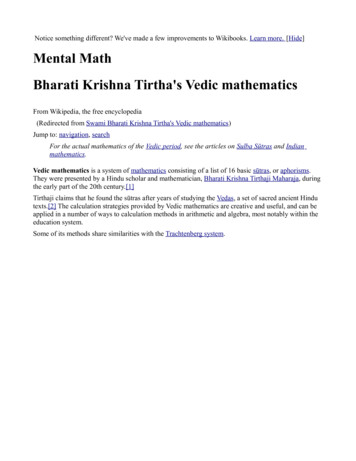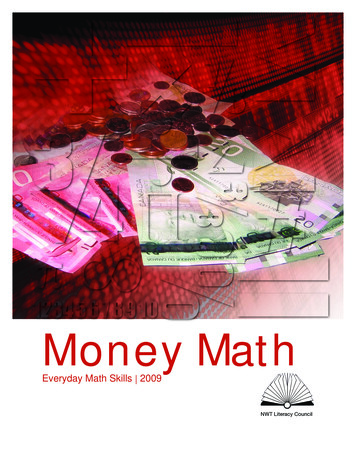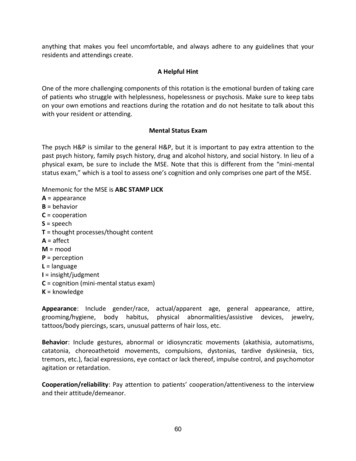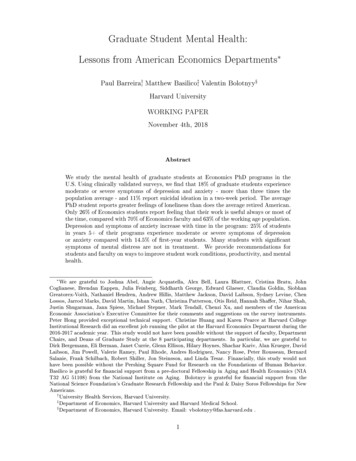
Transcription
Notice something different? We've made a few improvements to Wikibooks. Learn more. [Hide]Mental MathBharati Krishna Tirtha's Vedic mathematicsFrom Wikipedia, the free encyclopedia(Redirected from Swami Bharati Krishna Tirtha's Vedic mathematics)Jump to: navigation, searchFor the actual mathematics of the Vedic period, see the articles on Sulba Sūtras and Indianmathematics.Vedic mathematics is a system of mathematics consisting of a list of 16 basic sūtras, or aphorisms.They were presented by a Hindu scholar and mathematician, Bharati Krishna Tirthaji Maharaja, duringthe early part of the 20th century.[1]Tirthaji claims that he found the sūtras after years of studying the Vedas, a set of sacred ancient Hindutexts.[2] The calculation strategies provided by Vedic mathematics are creative and useful, and can beapplied in a number of ways to calculation methods in arithmetic and algebra, most notably within theeducation system.Some of its methods share similarities with the Trachtenberg system.
Contents[hide] 1Tirthajiand thepromotion ofVedicmathematics 2Originof thesystem 3 Thesūtras(formulae oraphorisms) 3.1Subsūtrasorcorollarie
[edit] Tirthaji and the promotion of Vedic mathematicsVedic mathematics was presented by Tirthaji, who is described as having the “rare combination of theprobing insight and revealing intuition of a Yogi with the analytical acumen and synthetic talent of amathematician”.[3] Born in India in 1884, Tirthaji was considered an exceptional scholar; by agetwenty he had studied at a number of colleges and universities throughout the country, been awardedthe title of Saraswati by the Madras Sanskrit Association for his remarkable proficiency in Sanskrit,and had completed seven masters degrees, including Sanskrit, Philosophy, English, Mathematics,History and Science, with the American College of Sciences.[4]Around 1911, Tirthaji resolved to study several sections of the Atharva-veda that had been dismissedby Orientalists, Indologists and antiquarian scholars as nonsensical.[5] He was part of a shrinkinggroup of Indian scholars who believed that the Vedas represented an “inexhaustible mine of profoundwisdom” both spiritual and secular (Pratyagatmananda, 1965). Tirthaji claimed that there were sectionsof the Atharva-veda labeled “ganita sūtras” or “mathematical formulae” that mysteriously made noobvious reference to mathematics.[6] Tirthaji explains that he was determined to understand the “ganitasūtra” references, and began studying ancient lexicons and lexicography in more detail.[7] With thisresolve, Tirthaji went to Sringeri, Karnataka, where he began years of solitary study and meditation.[8]Eight years later, Tirthaji emerged claiming to have deciphered 16 fundamental mathematical sūtras inthe Vedas, which today have become the foundation of Vedic mathematics.[9] According to Tirthaji, thesūtras cover every branch of mathematics, from arithmetic to spherical conics, and that “there is nomathematics beyond their jurisdiction”.[10]After discovering the sūtras, Tirthaji traveled around India presenting Vedic mathematics, and evenlectured in the United States and England in 1958 (Trivedi, 1965). In addition to lecturing, Tirthaji alsowrote sixteen volumes, one for each basic sūtra, explaining their applications.[11] Before they werepublished, the manuscripts were lost irretrievably.[clarification needed][12] Before falling ill and dyingin 1960, Tirthaji was able to rewrite the first of the sixteen volumes he had composed.[13] This text —simply titled Vedic Mathematics, and published in 1965 — has become the basis for all study in thearea.[14][edit] Origin of the systemThere has been much controversy among Indian scholars about Tirthaji’s claims that the mathematics isVedic and that it encompasses all aspects of mathematics (Kansara, 2000).First, Tirthaji’s description of the mathematics as Vedic is most commonly criticised on the basis that,thus far, none of the sūtras can be found in any extant Vedic literature (Williams, 2000). Whenchallenged by Prof K.S. Shukla to point out the sutras in question in the Parishishta of the AtharvaVeda, the swamiji is said to have said that the sixteen sutras were not in the standard editions of theParishishta, and that they occurred in his own Parishishta and not any other.[15][16] Considering thelack of references to the sūtras, coupled with the fact that the language style does not seem Vedic, somepropose that the sūtras were simply composed by Tirthaji himself (Agrawala, 1992).Critics have questioned whether this subject deserves the name Vedic or indeed mathematics. Theypoint to the lack of evidence of any sutras from the Vedic period consistent with the system, theinconsistency between the topics addressed by the system (such as decimal fractions) and the knownmathematics of early India, the substantial extrapolations from a few words of a sūtra to complexarithmetic strategies, and the restriction of applications to convenient, special cases. They further saythat such arithmetic as is sped up by application of the sūtras can be performed on a computer or
calculator anyway, making their knowledge rather irrelevant in the modern world.[17]They are also worried that it deflects attention from genuine achievements of ancient and modernIndian mathematics and mathematicians, and that its promotion by Hindu nationalists may damagemathematics education in India.[18]In response to criticisms that the sūtras cannot be located within the texts, several people haveexplained how textual references should not be the basis for evaluating the Vedicity of the mathematics(Agrawala, 1992). Some propose that Vedic mathematics is different than other scientific work becauseit is not pragmatically worked out, but is based on a direct revelation, or an “intuitional visualisation”of fundamental mathematical truths (Agrawala, 1992; Pratyagatmananda, 1965). Tirthaji has beendescribed as having the same “reverential approach” towards the Vedas as the ancient rishis that formedthem. Thus, it seems as though some believe that Tirthaji may not have found the sūtras within theVedas, but that he received them spiritually as the rishis did, which should validate them as Vedic. Thecontroversy about the Vedicity of the mathematics is further confused by the double meaning of veda.Since veda can be translated to mean ‘knowledge’, it is also possible that Vedic mathematics simplyrefers to the fact that the sūtras are supposed to present all knowledge of mathematics. Tirthaji’sdefinition of veda does not clearly clarify whether he uses it to represent ‘all knowledge’ or the Vedictexts; rather, it seems that he uses it to refer to both.[edit] The sūtras (formulae or aphorisms)Vedic mathematics is based on nineteen sūtras which serve as somewhat cryptic instructions for dealingwith different mathematical problems. Below is a list of the sūtras, translated from Sanskrit intoEnglish: "By one more than the previous one" [19]"All from 9 and the last from 10"[20]"Vertically and crosswise (multiplications)"[21]"Transpose and apply"[22]"Transpose and adjust (the coefficient)"[23]"If the Samuccaya is the same (on both sides of the equation, then) that Samuccaya is (equal to)zero"[24][25]By the Parāvartya rule [26][27]"If one is in ratio, the other one is zero." [28]"By addition and by subtraction."[29]By the completion or non-completion (of the square, the cube, the fourth power, etc.)[30][31]Differential calculus [32][33]By the deficiencySpecific and generalThe remainders by the last digit"The ultimate (binomial) and twice the penultimate (binomial) (equals zero),"[34]"Only the last terms,"[35][36][37][38]By one less than the one beforeThe product of the sumAll the multipliers
[edit] Subsūtras or corollaries "Proportionately"[39]The remainder remains constant"The first by the first and the last by the last" [40]For 7 the multiplicand is 143By osculationLessen by the deficiency"Whatever the extent of its deficiency, lessen it still further to that very extent; and also set upthe square (of the deficiency)".[41]"By one more than the previous one"[42]"Last totaling ten"[43][44]The sum of the products"By (alternative) elimination and retention (of the highest and lowest powers)"[45]By mere observation,[46][47]The product of the sum is the sum of the productsOn the flagEditor's list of 16 Sūtras and 13 Sub-sūtras or corollaries from the Vedas[48]To check the factorization of polynomial expressions: "The product of the sum of the coefficients (SC)in the factors is equal to the sum of the coefficients in the product." The SC of the product (theexpression) Product of the SC (in the factors). Additionally, this sub-sūtra helps to fill in the gapswhen some factors are known.[49][edit] Background information on the VedasThe word “veda” has two basic meanings. The first, a literal translation of the Sanskrit word, is“knowledge” (Veda). The second, and most common meaning of the word, refers to the sacred ancientliterature of Hinduism, the Vedas, a collection of hymns, poetry and Hindu ceremonial formulae(Veda). Believed to be one of the oldest human written records, the Vedas date back over 4000 years(Gaskell, 2000). Traditionally, they were passed down orally and adapted from generation to generationby sacred sages called rishis, before eventually emerging written in Vedic, an ancient form of Sanskrit.The Vedas are divided into four main sections: the Rig-veda, Sama-veda, Yajur-veda and the Atharvaveda, known collectively as the Samhitas (Veda). The first three, the Rig-veda, Sama-veda, and Yajurveda are basically ritual handbooks that were used by priests during the Vedic period (1500–500 BCE)(Veda). Vedic mathematics is apparently part of the fourth Veda, Atharva-veda, which is distinct fromthe others in several ways. First, unlike the religious focus of the other Vedas, the Atharva-vedacontains hymns, spells and magical incantations for personal and domestic use (Veda). Also, theAtharva-veda, which was written later than the other Vedas, was not always considered authoritative,but only became so after being accepted by the Brahmans, the highest order of Hindu priests (Veda).Collectively, the Vedas do include information about a huge range of subjects, spanning religion,medicine, architecture, astronomy, etc. (Gaskell, 2000).Although there is controversy about whether the Vedas themselves actually include references tomathematics, the roots of sophisticated mathematics have actually been traced back to the Vedic era.Ancient Indian Vedic civilizations are known for being skilled in geometry, algebra and computationalmathematics complex enough to incorporate things like irrational numbers (Dutta, 2002). Furthermore,
all ancient Indian mathematics literature is composed completely in verse; there was a tradition ofcomposing terse sūtras, like those of Vedic mathematics, to ensure that information would be preservedeven if written records were damaged or lost (Dutta, 2002).[edit] Methods described in the sūtrasIt is not difficult to understand and apply the Vedic mathematical strategies, as long as one does not relyon the sūtras alone for mathematical insight. Those studying Vedic mathematics tend to strongly rely onthe examples and explanations Tirthaji provides in his book.[edit] All from nine and the last from tenWhen subtracting from a large power of ten with many columns of zeros, it is not necessary to write thenotation for "borrowing" from the column on the left. One can instead subtract the last (rightmost) digitfrom 10 and each other digit from 9. For example, when one is subtracting ten thousand minus 4,679,the leftmost three digits of 4,679—4, 6 and 7--are subtracted from 9, and the rightmost nonzero digit—that is, 9--is subtracted from 10, yielding the solution: 5,321. This method is also used when finding thedeficit from the next larger power of ten when setting up a multiplication problem using the "crosssubtraction" method.[50][edit] First corollary, when squaring numbers"Whatever the extent of its deficiency, lessen it still further to that very extent; and also set up thesquare (of that deficiency)"[51]For instance, in computing the square of 9 we go through the following steps:1. The nearest power of 10 to 9 is 10. Therefore, let us take 10 as our base.2. Since 9 is 1 less than 10, decrease it by the deficiency (9 - 1 8). This is the leftmost digit ofour answer.3. On the right hand side put the square of the deficiency, which is 1². Hence, the square of nine is81.Similarly, 8² 64, 7² 49, 6² 36.For numbers above 10, instead of looking at the deficit we look at the surplus. For example:and so on.This method of squaring is based on the fact that a2 (a b)(a b) b2[52] where a is the number
whose square is to be found and b is the deficit (or surplus) from nearest product of 10.[edit] By one more than the one before"Ekādhikena Pūrveṇa" is the Sanskrit term for "[by] One more than the previous one". It provides asimple way of calculating values like 1/x9 (e.g: 1/19, 1/29, etc). The sūtra can be used for multiplyingas well as dividing algorithms.For example, to calculate 1/19, x 1 . For the multiplication algorithm (working from right to left), themethod is to start by denoting the dividend, 1, as the first (rightmost) digit of the result. Then that digitis multiplied by 2 (i.e.: x 1 ), and noted to that next digit to its left. If the result of this multiplicationwas greater than 10, (value – 10) is noted, and the "1" is noted as a carry which will be added to thenext digit directly after multiplying.The preposition "by" means the operations this formula concerns are either multiplication or division.[In case of addition/subtraction preposition "to" or "from" is used.] Thus this formula is used for eithermultiplication or division. It turns out that it is applicable in both operations.Note: This sūtra can also be applied to multiplication of
Vedic and that it encompasses all aspects of mathematics (Kansara, 2000). First, Tirthaji’s description of the mathematics as Vedic is most commonly criticised on the basis that, thus far, none of the sūtras can be found in any extant Vedic literature (Williams, 2000). When challenged by Prof K.S. Shukla to point out the sutras in question in the Parishishta of the Atharva Veda, the swamiji .











